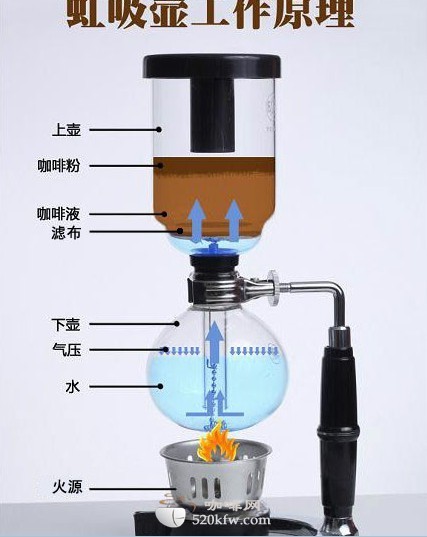Coffee technology siphon pot method of making coffee

In 1840, a glass test tube in a laboratory triggered the invention of the siphon coffee maker (Syphon). The British took the test tube used in Biya's chemical experiment as a model to create the first vacuum coffee pot. Two years later, Mrs. Bachang of France improved the kettle with a little spring in shape, and the familiar upper and lower convection siphon pot was born.
The siphon coffee maker lived in France for a long time, but never got a good chance to be very popular.
It became popular for the first time when it was brought to Denmark and Japan in the mid-20th century.
The Japanese like the "tortoise hair" personality of the siphon pot technology standard, carefully deliberating the complex relationship between the size of coffee powder, water and time to mobilize the whole army, and develop a well-regulated coffee path.
The aestheticist Danes focused on functional design, Peter, who imported siphon pots from France in the mid-1950 s. Bolton (Peter Bodum), who thought French-made pots were expensive and difficult to use, partnered with architect Kaas Klaeson to develop Bodum's first styling siphon pot, which went public under the name "Santos".
Siphon coffee maker always has a hint of mystery in most people's impression. Siphon coffee maker plays an important role in the history of coffee development in Taiwan. In recent years, so-called ground coffee (Italian espresso) has become very popular. In comparison, this siphon coffee maker requires higher technology and more cumbersome procedures. In today's industrial and commercial society, there is a tendency to decline gradually, but the mellow flavor of coffee brewed by siphon coffee pot can not be compared with ground coffee brewed by machine.
Most people often have little knowledge of it, or even have the wrong impression, there are usually two extreme views, one is that some people are cautious and frightened about it, and what about the other? It is thought that using a siphon coffee maker is nothing more than boiling the water and stirring the coffee powder; in addition, some people think that the siphon coffee pot looks very dangerous, but as long as it is improperly used, every method of brewing coffee has hidden dangers.
Siphon pot (Syphon), commonly known as "glass ball" or "siphon", is a simple and easy-to-use method of coffee brewing, and it is also one of the most popular coffee brewing methods in cafes. Although the siphon kettle has the nickname of "plug wind type", it has nothing to do with the siphon principle, but uses water heating to produce water vapor, causing thermal expansion and cold contraction, pushing the hot water from the lower sphere to the upper pot, and then sucking back the water from the upper pot after the lower pot cools. Does that sound mysterious? Not at all. Follow the following steps and you will understand!
Prepare supplies
A set of siphon pots, industrial alcohol, lighters, bamboo spoons for mixing, dry wet rags.
Process
First, fill the water-hook the filter element
Fill the pot with hot water and mark it with the "two cups" icon. Put the filter element into the pot, hold the end of the chain with your hand, and gently hook it to the end of the glass tube. Be careful not to release the hook suddenly, so as not to damage the glass tube of the upper pot.
Second, ignite-insert the pot diagonally-waiting for big bubbles
Light the alcohol lamp and insert the upper pot obliquely so that the rubber edge is pressed against the spout of the next pot (rest assured that the upper pot will not fall off) so that the chain is soaked in the water. Then boil the water and wait for the pot to produce continuous bubbles. Just put the upper pot diagonally, don't let it clog the next pot, small bubbles don't count, wait for big bubbles to appear.
Third, upright-insert it into the upper pot
When large bubbles appear continuously in the lower pot, straighten the upper pot, shake it left and right and press it down slightly so that it is gently stuffed into the lower pot. After the upper pot is plugged in, you can see that the water in the next pot begins to climb up. If you have a bean grinder, you can start grinding beans now! Two cups of water use a medium grinding scale of three spoonfuls of coffee (about 24g)
Fourth, let the water in the lower pot rise completely to the upper pot.
After the water has completely risen to the pot, don't worry, wait a few seconds, and then prepare to pour in the coffee powder after the bubbles in the pot decrease a little.
Fifth, pour in the coffee powder-stir (left and right)
Pour in the ground coffee powder and move it around with a bamboo spoon to evenly remove the coffee powder into the water. The timing starts at the same time as the first stirring.
Stir gently to avoid violent stirring. If it is fresh coffee powder, it will float on the surface to form a layer of powder. At this time, the coffee powder needs to be stirred so that the flavor of the coffee can be completely extracted. The correct stirring action is to move the bamboo spoon in the left and right direction, with a "strong way" of downward pressure, to "press" the coffee powder floating on the surface of the water below the surface.
6. Stir twice more.-flameout
After the first stirring, time 30 seconds, make the second stirring, and then time 20 seconds for the final stirring-- the alcohol lamp can be removed. Take the pre-prepared (wrung-dry) slightly wet dishcloth and gently wrap the side of the lower pot from the side to prevent the wet cloth from touching the place where the alcohol flame at the bottom of the pot comes into contact, so as to prevent the pot from breaking. At this time, you can see that the water in the upper pot is quickly "pulled" to the lower pot. If your coffee is fresh enough, there will be a lot of light brown foam in the pot.
VII. Completion
After the coffee is sucked into the lower pot, hold the upper pot in one hand and the handle of the lower pot in the other, gently shake the upper pot to the left and right to pull out the upper pot and the lower pot. Pour the coffee into a warm coffee cup and enjoy the mellow coffee that you have prepared by hand.
Be careful
Brewing coffee in a siphon pot tends to be more insipid than a follicle, because part of the water in the tube in the upper pot does not flow into the upper pot to come into contact with coffee powder. In addition, due to the alcohol lamp has been heated, inclined to high-temperature extraction, so it is easy to make bitter or astringent taste excessive extraction and become stronger. The solution is to stir the coffee powder or thoroughly control the extraction time.
After making coffee in a siphon pot, it should be cleaned in time, especially the filter cloth, which should be properly preserved.
Cleaning method
1. Hold the glass tube in the upper seat with your hand and gently pat the mouth of the bottle with the palm of your left hand.
two。 Then, tap three more times around the glass to make the coffee powder loose.
3. After the coffee powder is poured out, rinse the inner edge of the cup with clean water and rinse gently around.
4. Then rinse the filter with clean water to remove the dregs.
5. Remove the filter spring hook and rinse thoroughly with clean water.
6. Use both hands to pick up the extrusion circle and wring it dry (please put the filter / cloth ice in the water when not in use to avoid oxidation)
7. Dip the cup brush with detergent, scrub the upper seat, be careful of the bottle mouth breaking, the glass tube hitting the sink or cup, etc.
Important Notice :
前街咖啡 FrontStreet Coffee has moved to new addredd:
FrontStreet Coffee Address: 315,Donghua East Road,GuangZhou
Tel:020 38364473
- Prev

Peruvian coffee beans from the world's fine coffee production area
Coffee is high-quality and balanced and can be used for mixed drinks. Peru (Peru) is also a big coffee producer. Up to 98% of Peruvian coffee is grown in forest areas, and most producers are small farmers. Peru has good economic conditions and a stable political situation, thus ensuring the good quality of coffee. However, there are many local problems, in addition to guerrilla warfare and drug trafficking, in the 20th century
- Next

Indonesia Sulawesi coffee bean boutique Traya
Sulawesi Indonesia Sulawesi Coffee beans Indonesia's world-famous boutique coffee is mainly produced by three islands, Sumatra, Java, and this time we got Sulawesi (Sulawesi). Sulawesi is the largest island in Indonesia. Sulawesi is a former Dutch colony whose original name was Celebes. Sulawesi, Sulawesi
Related
- Guji coffee producing area of Guji, Ethiopia: Humbela, Shakiso, Wulaga
- What is the most expensive variety of Qiloso in BOP multi-variety group?
- How to store the coffee beans bought home?
- Why are Yemeni coffee beans so rare now?
- Ethiopian Sidamo all Red Fruit Sun Sun Santa Vini Coffee beans
- SOE is mostly sour? What does it mean? Is it a single bean? what's the difference between it and Italian blending?
- Is Italian coffee beans suitable for making hand-brewed coffee?
- How to choose coffee beans when making cold coffee? What kind of coffee beans are suitable for making cold coffee?
- Just entered the pit to make coffee, what kind of coffee beans should be chosen?
- Can only Japan buy real Blue Mountain Coffee? What are authentic Jamaican Blue Mountain coffee beans?

